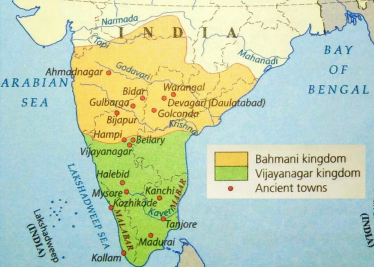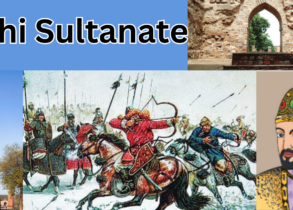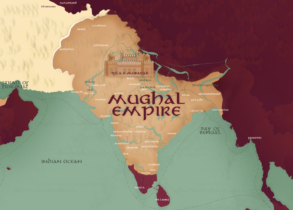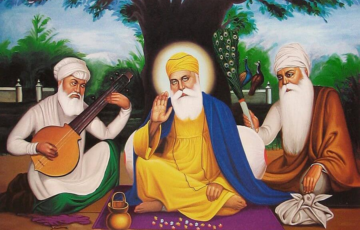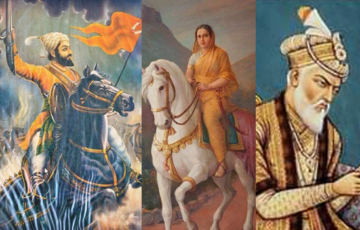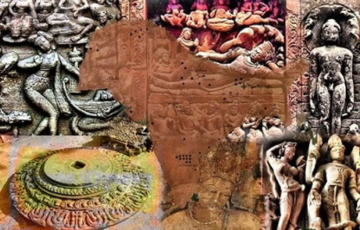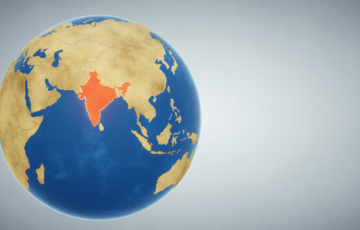BAHAMANI AND VIJAYANAGARA EMPIRE
During the early 14th century, the Deccan and South India witnessed the emergence of four prominent kingdoms:
- Yadavas of Devagiri: Located in the Western Deccan, corresponding to present-day Maharashtra.
- Hoysalas of Dvarasamudra: Centered around Dvarasamudra in Karnataka.
- Kakatiyas of Warangal: Occupying the eastern part of present-day Telangana, the Kakatiyas held sway.
- Pandyas of Madurai:Ruling over southern Tamil Nadu from the city of Madurai.
During the reign of Alauddin Khalji, these states faced defeat at the hands of General Malik Kafur in 1304 and 1310. Muhammad Tughluq’s unsuccessful attempt to relocate the capital to Devagiri (Daulatabad) further destabilized the region, prompting southern subordinates to seek independence upon his return to Delhi.
Rise of the New Kingdoms:
In 1336, the Vijayanagar kingdom was established by the Sangama brothers, Harihara and Bukka, at Vijayanagara, present-day Hampi, situated on the southern bank of the Tungabhadra River. Following suit, in 1345, Zafar Khan declared independence from the Sultanate and assumed the title Bahaman Shah, marking the inception of the Bahmani dynasty.
VIJAYANAGAR EMPIRE (1336-1650 AD)
The Vijayanagar Empire, also referred to as the Karnata Kingdom, emerged in 1336 CE along the southern banks of the Tungabhadra River, in present-day Karnataka, India.
- The empire was established by the brothers Harihara and Bukka, who hailed from the pastoralist Kuruba community.
- Prior to founding Vijayanagar, both brothers had served under Vira Ballala III, the Hoysala King.
- The revered Saiva saint and Sanskrit scholar, Vidyaranya, is believed to have played a significant role in the empire’s establishment.
- Initially, the capital was situated near Anegondi on the northern bank of the Tungabhadra River.Later, it was relocated to Hosapattana, a Hoysala town near Hampi, on the southern bank, and renamed Vijayanagara, meaning “city of victory.”
- The name Hampi is derived from the local mother goddess, Pampadevi.
- The ruins of Hampi came to light in 1800 when Colonel Colin Mackenzie revealed them to the world.
- Mackenzie’s efforts led to his appointment as the first Surveyor General of India in 1815.
- Religious Significance:
- The guardian deity of thekingdom was Virupaksha, regarded as a manifestation of Shiva, symbolizing the empire’s deep religious roots.
- All royal orders were signed “Shri Virupaksha,” usually in the Kannada scrip
- They adopted the emblem of the Chalukyas, the Boar, or Varaha, as their royal insignia.
Through military conquests, the Vijayanagar Empire expanded its territories, incorporating several regions into its dominion:
- The entirety of the Hoysala kingdom in Karnataka.
- Coastal Andhra,where power struggles between the Gajapati kingdom of Orissa and Vijayanagar ensued.
- Tondai-mandalam,located in northern Tamil Nadu and southern Andhra. Prince Kumara Kampana, son of Bukka I, secured this region. Additionally, he defeated the Madurai Sultan around 1370, effectively ending the Sultanate, as chronicled in “Madura-vijayam,” a Sanskrit work authored by Kampana’s wife, Gangadevi.
- Until 1500, the Pandya region, including Madurai, remained independent of Vijayanagara. Only the northern and central Tamil areas up to the Kaveri delta were under the governance of the Sangama and Saluva dynasties.
- The Konkan area, a narrow strip situated between the Western Ghats and the Arabian Sea.
- At its zenith, the empire stretched from the river Krishna in the north to the southernmost tip of the peninsula.
| Sangama Dynasty | |
| Harihara (1336-56) | ● Defeated the Hoysala ruler of Mysore and executed him.
● Captured Belgaum and Goa from the Bahamani kingdom. ● Launched an expedition to northern Sri Lanka. |
| Bukka (1356-77) | ● Founded a new city on the southern bank of a tributary to the river Krishna, ruling his kingdom as the agent of a deity believed to own all land south of the river Krishna. |
| Deva Raya I (1404-1422) | ● Initially defeated by Bahmani ruler Firuz Shah but later allied with Warangal, shifting the balance of power in the Deccan. He defeated Firuz Shah Bahmani and annexed the entire Reddi territory up to the mouth of the Krishna River.
● Constructed a dam across the Tungabhadra and Hiradra rivers and utilized canals to address water scarcity. ● Visited by Nicolo Conti in 1420. |
| Devaraya II (1422–46) | ● Considered the greatest ruler of the Sangama dynasty.
● Defeated the Gajapati rulers of Odisha. ● Recruited trained Muslim cavalry and provided archery training to his soldiers, according to Ferishta, the Court Historian of Deccan Sultans. ● Visited by Abdur Razaak during his reign, who also visited the Zamorin of Kochi. ● Attempted to recover areas like Mudkal and Bankapur from the Bahamani sultans in 1443 but ultimately agreed to maintain existing frontiers. ● Tribute was paid to him by the kings of Sri Lanka and Tennasserim (Malay and Burma), according to Nuniz. ● Lack of primogeniture led to a series of civil wars for the throne after his demise. |
| Saluva Dynasty | |
| Saluva Narasimha (1485-1505) | ● Saluva Narasimha established the Saluva dynasty in 1485.
● The Saluvas were renowned for their military leadership and prowess. ● His elder son, Viranarsimha, began the Tuluva dynasty in 1505. |
| Tuluva Dynasty | |
| Krishna Deva Raya (1509–29) | ● Regarded as the greatest among all Vijayanagara rulers, Krishna Deva Raya, also known as Andhra Bhoj, built upon the strong military foundation established by his father and elder brother, Vira Narasimha.
● Engaged in battles on two fronts against the traditional enemy, the Bahmani Sultans, and the Gajapati rulers of Orissa. ● Acquired the Raichur Doab in 1512, subdued the rulers of Orissa in 1514, and defeated the Sultan of Bijapur in 1520. ● Inscriptions describe his capture of numerous Gajapati forts, including those in Udayagiri, and the erection of a victory pillar at Simhachalam (Visakhapatnam). ● Established authority along the Malabar and Konkan coasts with the assistance of the Portuguese, who were permitted to construct a fort in Bhatkal, Karnataka. ● Made significant contributions to temples such as Srisailam, Tirupati, Kalahasti, Kanchipuram, Tiruvannamalai, and Chidambaram, adding towering gopurams to enhance their grandeur. ● Undertook architectural projects, including the foundation of Nagalapuram near Vijayanagar and the addition of gopurams to important temples like Vijay Mahal and Vittala Swamy Temple. ● Earned praise for his character and the opulence of Vijayanagara City from foreign visitors such as Domingo Paes, Fernao Nuniz, and Duarte Barbosa. ● A skilled scholar proficient in Telugu and Sanskrit, his literary works include the renowned Telugu poem “Amuktamalyada,” Sanskrit works like “Madalasa Charita,” “Satyavedu Parinaya,” “Rasamanjari,” and “Jambavati Kalyanam,” as well as “Krishna Deva Rayana Dinachari” in Kannada. ● Patronized renowned poets like Allasani Peddana, Madayyagari Mallana, Nandi Thimmana, Dhurjati, Rambhadra, Pingali Surana, Ramarajabhushanudu, and Tenali Ramakrishna. ● Supported claimants to power in the Sultanates despite religious differences, earning the title “establisher of the Yavana kingdom,” where Yavana refers to Greeks and other peoples entering the subcontinent from the northwest. ● Implemented a taxation system based on fixed rates depending on the quality of land and an industry tax on private workshop owners.
|
| Achyuta Deva Raya
(1529-1542)
|
● Succeeded Krishna Deva Raya to the throne, with support from the influential Chellappa, also known as Saluva Nayak.
● Succeeded by Sadasivaraya in 1542.
|
| Aravidu Dynasty | |
| Sadasivaraya (1543-67)
|
● Real power was wielded by his minister Rama Raya, who garnered support from kinsmen of the Aravidu clan by appointing them as Nayaks of strategic localities.
● A skilled warrior and strategist, Rama Raya manipulated Bahmani Muslim powers against each other and entered into a commercial treaty with the Portuguese to disrupt the supply of horses to the Bijapur ruler. ● Initially fought against the Bijapur ruler but later allied with Bijapur against Golkonda and Ahmadnagar, culminating in the Battle of Talikota. |
| Important Facts
● Shri Laxmanadeva Raya constructed the Bhoramdeo Temple. ● The lady poet who described the victorious expeditions of her husband in her work ‘Madhura-Vijayam’ was Ganga Devi. ● The battle of Golconda was fought between the king of Vijayanagara, Krishnadeva Raya, and the Sultan of Golconda, Quli Qutb Shah. ● The ‘Ashtadiggajas’ in the court of Krishnadeva Raya were eight Telugu poets. ● The ruling period of Krishnadeva Raya was the golden age of Telugu literature. ● Krishnadevaraya, ruler of Vijaynagar, wrote the treatise ‘Amuktamalyada,’ and he was known as Andhra Bhoj. Allasani Peddana, a Telugu poet, adorned his court. ● Krishnadeva Raya founded the city of Nagalapura. ● The famous Hazara temple of Vijayanagara was built during the reign of Krishnadeva Raya. ● Abdur Razzaq visited Vijayanagara during the reign of Devaraya-II. ● Nicolo Conti was an Italian traveler who visited the Vijayanagara empire. ● According to Portuguese writer Nuniz, women in the Vijayanagara Empire were expert in wrestling, astrology, accounting, and soothsaying. ● Srinath, the famous Telugu poet, was in the court of Pedakomati Vemareddy of Kondaveedu. ● Nannaya and Tikkana were famous for Telugu translation. ● Sayana, the famous commentator of the Vedic texts, flourished during the reign of Vijayanagara kings. ● The Battle of Talikota was fought between Vijayanagara and the combined forces of Bijapur, Ahmadnagar, and Golconda.. ● When Raja Wodeyar founded the Kingdom of Mysore, Venkata-II was the ruler of the Vijayanagara Empire. ● Bukka-I, the ruler of Vijayanagara, had sent his ambassador to the Emperor of China. ● Building Kalyaana Mandapas’ was a notable feature in the temple construction in the kingdom of Vijayanagara. ● The famous Vijaya Vitthal Temple, having its 56 carved pillars emitting musical notes, is located in Hampi. |
Bahmani Kingdom (1347-1527 Ad)
Political History of the Bahmani Sultanate:
- The Bahmani Sultanate was founded by Alauddin Hassan Gangu Bahaman Shah in 1347 AD.
- A rivalry ensued with the Vijayanagar kingdom over control of the fertile region of Raichur doab, persisting throughout the Bahmani rule.
- Bahman Shahengaged in frequent conflicts with the Warangal state, as well as the Rajhmundry and Kondavidu Reddy kingdoms. Notably, he emerged victorious in all these expeditions, earning the title of Second Alexander on his coins.
- Upon Bahman Shah’s demise, he was succeeded by Mohammed I.
- Mohammed I’s attack on Warangal in 1363 resulted in a substantial indemnity, including the acquisition of the fortress of Golkonda and the coveted turquoise throne, which later became symbolic of Bahmani kingship.
- Over the subsequent century, a succession of Sultans, through inheritance or usurpation, continued to engage in conflicts with their southern neighbors, albeit without significant territorial gains.
- Warangal was eventually conquered in 1425, but further eastward expansion was impeded by the rulers of Orissa.
- In 1429, Ahmed Shah al Wali relocated the capital from Gulbarga to Bidar.
Administration of the Bahmani Sultanate:
- The kingdom was administratively divided into four provinces known as “taraf” – Daulatabad, Bidar, Berar, and Gulbarga.
- Each province was headed by atarafdar, also referred to as a subedar.
- A portion of land within the jurisdiction of the tarafdar was designated as Khalisa land, utilized to finance the expenses of the king and the royal household.
- Nobles within the kingdom were remunerated through cash payments or grants of land, known as ‘jagir.’
Important Rulers
| Ruler | Contribution |
| Bahman Shah (1347–1358) | ● In 1345, Bahman Shah, also known as Zafar Khan and Hasan Gangu, proclaimed independence at Devagiri before later relocating his capital to Gulbarga in northern Karnataka.
● Faced with opposition from rulers in Warangal, Orissa (Jajnagar), and Vijayanagar, Bahman Shah undertook successful military campaigns, earning the title of the Second Alexander on his coins. ● Adopting the administrative structure of the Delhi Sultanate, he divided his realm into four regions, termed as ‘Tarafs’ – Gulbarga, Daulatabad, Bidar, and Berar. Each region was governed by a Governor responsible for administration, revenue collection, and military command. |
| Mohammed I (1358–1375) | ● In 1363, Mohammed I led an attack on Warangal, securing the fortress of Golkonda and the renowned Turquoise Throne, which subsequently served as the Bahmani kings’ royal seat.
● He established a governmental system that became the model for all successor sultanates as well as the Marathas. Additionally, measures were implemented to curb highway robbery, and two mosques were constructed at Gulbarga. ● Over a century, subsequent Sultans, often through usurpation, engaged in battles in the southern territories with limited territorial gains. ● Although Warangal was captured in 1425, further eastward expansion was hindered by Orissan rulers. Ahmad Wali Shah later transferred the capital from Gulbarga to Bidar in 1429. |
| Mohammad III (1463–1482):
Mohammed Gawan was his lieutenant (Prime Minister)
|
● Mahmud Gawan, a Persian trader turned Prime Minister, steered the Bahmani kingdom to its apex.
● He was Known for military prowess, Gawan secured victories against Vijayanagar, Orissa, and Arabian Sea pirates, solidifying the Bahmani realm’s dominance. ● His architectural legacy includes the construction of a Madarsa in Bidar, reflecting exquisite Persian design elements. ● The Madarsa became a renowned center of learning, boasting a vast collection of 3000 manuscripts from diverse corners of the world. ● Despite his remarkable contributions, native Muslim leaders harbored resentment towards Gawan’s ascent. Falsely accused and condemned, he faced a tragic end with a sentence of death at the hands of the Sultan. ● Gawan’s execution marked the onset of the Bahmani Sultanate’s decline, paving the way for its eventual disintegration into five independent kingdoms: Bijapur, Ahmednagar, Berar, Golkonda, and Bidar. |
| Council of eight ministers |
| 1. Vakil-us-saltana: The chief lieutenant and immediate subordinate of the sovereign.
2. Waziri-kull: Overseer of all other ministers, ensuring coordination and efficiency in governance. 3. Amir-i-jumla: Minister of Finance, responsible for managing the kingdom’s financial affairs. 4. Wasir-i-ashraf: Minister of Foreign Affairs and Master of Ceremonies, handling diplomatic relations and ceremonial duties. 5. Nazir: Assistant minister for finance, supporting the Amir-i-jumla in financial matters. 6. Peshwa: Collaborator with the chief lieutenant, aiding in the administration of the kingdom. 7. Kotwal: Chief of police and city magistrate in the capital, maintaining law and order. 8. Sadr-i-jahan: Chief justice and Minister of Religious Affairs and Endowments, overseeing legal matters and religious institutions. |
Division of Bahmani
After the dissolution of the Bahmani kingdom, five formidable states emerged: Bijapur, Ahmednagar, Berar, Golkonda, and Bidar.
| Sultanate | Ruling Dynasty | Founder | Capital | Fate |
| Ahmadnagar | Nizam Shahi | Malik Ahmed Shah Bahri | Ahmadnagar | ● Emerged in northwestern Deccan between Bijapur and Gujarat Sultanates
● Founded by Malik Ahmed Shah Bahri, declaring independence in 1490 ● Initially, Junnar was the capital, later shifted to Ahmadnagar in 1494 ● Berar annexed during Murtaza Shah’s reign ● Successfully resisted Mughal invasion under regent Chand Bibi ● Continued resistance led by Malik Ambar from Paranda after Chand Bibi’s death ● Murtaza Shah II declared sultan in 1600, with a new capital at Khadki ● Conquered by Aurangzeb in 1636 AD |
| Bijapur | Adil Shahi | Ismail Adil Shah | Bijapur | ● Located in southwestern India
● Declared independence from Bahmani Empire in 1490 under Ismail Adil Shah ● Capital situated in Bijapur ● Annexed Bidar in 1619 ● Maratha revolt weakened Bijapur, ultimately annexed by Aurangzeb in 1686 |
| Golkonda | Qutb Shahi | Sultan Quli Qutub-ul-Mulk | Golkonda | ● Situated in southern India
● Founded by Sultan Quli Qutub-ul-Mulk ● Conquered by Aurangzeb in 1687 AD |
| Bidar | Barid Shahi | Qasim Barid | Bidar | ● Declared independence from Bahmani Empire in 1492 under Qasim Barid
● Smallest of the Deccan sultanates ● Annexed by the Bijapur Sultanate in 1619 |
| Berar | Imad Shahi | Fath-ullah Imad-ul-Mulk | Berar | ● Founded by Fath-ullah Imad-ul-Mulk
● Annexed by Ahmadnagar kingdom in 1574 AD |
Bannihatti Battle and Its Aftermath:
- In 1565, the Deccani states united forces and decisively defeated the Vijayanagara Empire at theBattle of Bannihatti, near Tallikota.
- Following this victory, the states resumed their individual pursuits.A dispute arose over Sholapur’s ownership, contested by both Ahmednagar and Bijapur.
Regional Conflicts and Alliances:
- Berar found support from Gujarat against Ahmednagar, which resulted in a conflict between Gujarat and Ahmednagar.
- Bijapur and Golconda engaged in a territorial dispute over Naldurg in Maharashtra.
- The Mughal Emperor Akbar’s conquest of Gujarat in 1572 initiated a new phase. Despite this, Akbar’s attention towards the Deccan remained limited due to other pressing matters.
Territorial Adjustments and Maratha Influence:
- Berar eventually fell to Ahmednagar, while an agreement between Ahmednagar and Bijapur allowed Bijapur to expand southward into Vijayanagara territory, while Ahmednagar gained control over Berar.
- Marathas began asserting themselves in Deccan affairs, with Deccani Brahmans overseeing revenue matters locally.
- Deccan rulers actively courted Maratha support, a strategy pioneered by Ibrahim Adil Shah of Bijapur.
Mughal Incursion and Concerns:
- Following the decline of the Delhi Sultanate, many sought employment under the Bahmani rulers, including Sufi saints.
- Akbar’s attention turned towards Deccan politics after consolidating control over Malwa and Gujarat in the 1560s and early 1570s.
- In 1576, the Mughals invaded Khandesh, compelling its rulers to capitulate. However, Akbar’s absence from India for twelve years from 1586 to 1598 weakened Mughal influence in the Deccan.
UPSC PREVIOUS YEAR QUESTIONS
1. Who among the following rulers of Vijayanagara Empire constructed a large dam across Tungabhadra River and a canal-cum-aqueduct several kilometers long from the river to the capital city? [2023]
a) Devaraya I|
b) Mallikarjuna
c) Vira Vijaya
d) Virupaksha
Ans: A
2. Regarding the taxation system of Krishna Deva, the ruler of Vijayanagar, consider the following statements: [2016]
1. The tax rate on land was fixed depending on the quality of the land
2. Private owners of workshops paid an ‘industries tax’
Which of the statements given above is/are correct?
a) 1 only
b) 2 only
c) Both 1 and 2
d) Neither 1 nor 2
Answer c
3. Who of the following founded a new city on the south bank of a tributary to river Krishna and undertook to rule his new kingdom as the agent of a deity to whom all the land south of the river Krishna was supposed to belong? [2015]
a) Amoghavarsha I
b) Ballala II
c) Harihara I
d) Prataparudra II
Answer c
4. In Medieval India, the designations ‘Mahattara’ and ‘Pattakila’ were used for: [2014]
a) Military officers
b) Village officers
c) Specialists in Vedic rituals
d) Chiefs of craft guilds
Answer b


